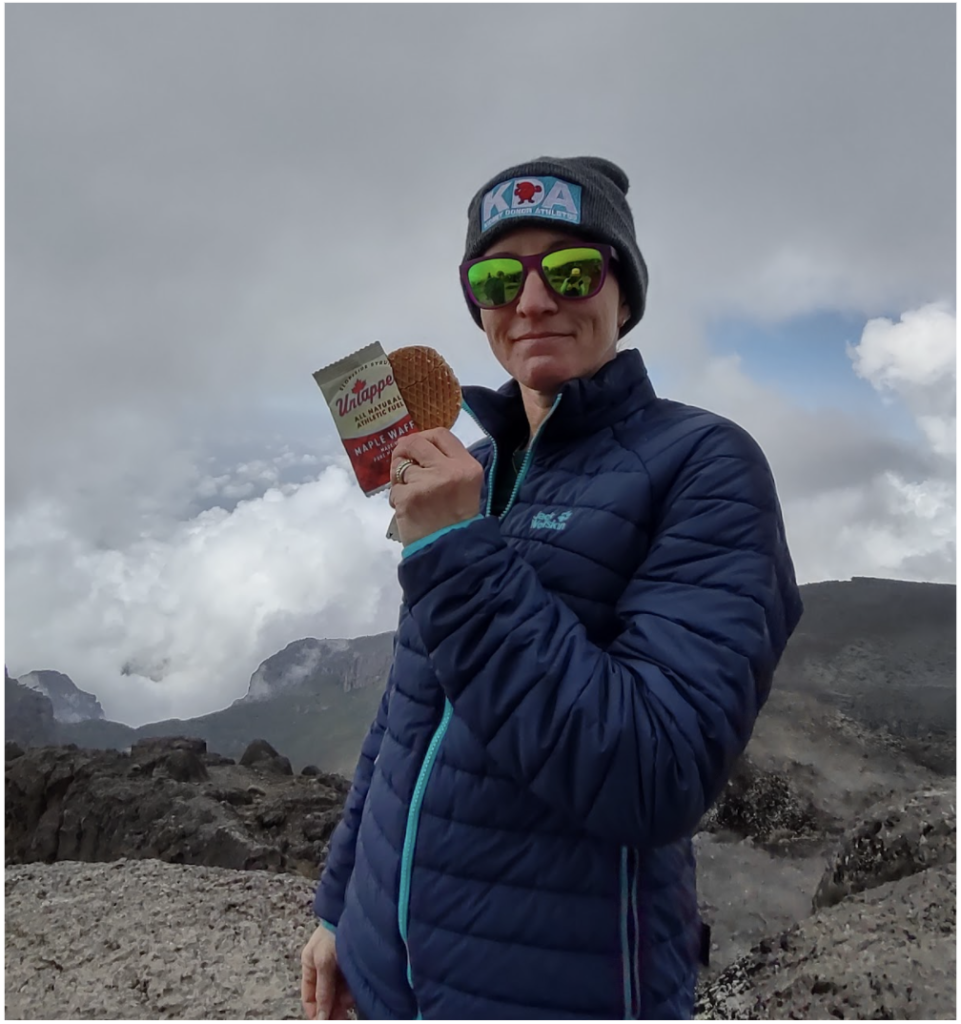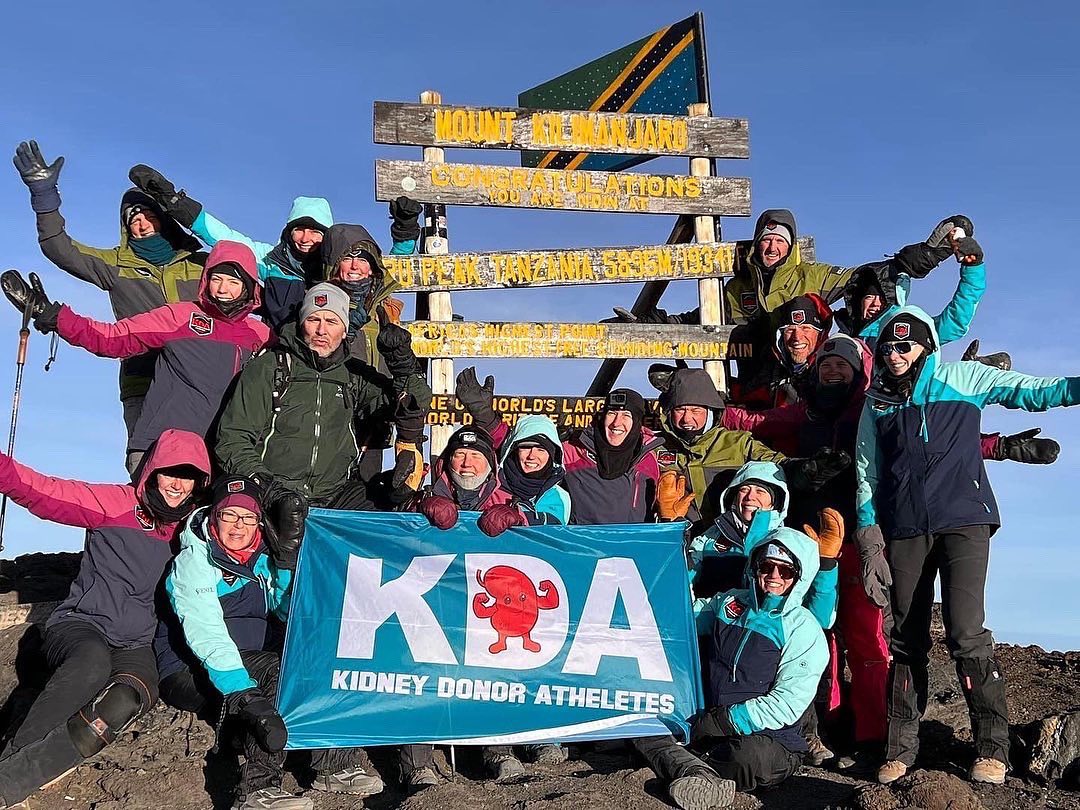March 10, 2022 marked World Kidney Day and the day when a group of 20 kidney donors reached the summit of Mount Kilimanjaro in Tanzania, Africa’s tallest peak (19,341 feet). Each participant had their own donation story, but this hike signified the common goal of sharing the message that it is possible to thrive and live an active and healthy life with one kidney. The project known as the One Kidney Climb included Vermonter and Maple lover Rebekah Thomas.
Donating blood is something we hear about often, but how did you get involved in being a living kidney donor and how did you make this decision?
Many years ago, I had a student who needed a kidney and liver transplant in order to survive. In 2011, she received both from living donors. I knew that living donation was fairly common, but after her experience, I decided that it was something that I would like to pursue myself. Interestingly, I ended up donating at the same hospital, UPMC in Pittsburgh, where she had her transplants. Her father and I actually had the same surgeon for our liver donations (I donated a lobe of my liver about 14 months prior to donating my kidney). The number of people waiting for a transplant is staggering – over 100,000 on the list for kidney and liver transplants. Some people wait for years, enduring energy zapping dialysis multiple times a week. An average of 13 people die each day in the US waiting for a transplant. I knew that for myself, it was the right choice to step forward as a donor. After my kidney donation, I found out that my recipient had been on the waiting list for nearly five years, and essentially had 0% kidney function at the time of transplant. I was very fortunate to be able to meet my recipients after our surgeries, and they are both doing well.
Prior to donating one of your kidneys you were very active from being an elementary school teacher, to coaching after school running programs to running ultra marathons. How did donating a kidney impact this?
Organ donation is major surgery, so taking time to recover properly is crucial. While still in the hospital, I was encouraged to get up and start walking as soon as possible. I made it a point to walk every day, adding a little more time each day, and trying to quicken my pace. For both donations, I was advised to wait at least 4 weeks before attempting to run, and it was around the 5 or 6 week mark that I added very slow running back into my routine. However, I did a lot more hiking during those weeks, as the impact was much less on my body, and more comfortable for all of those healing abdominal incisions. Little did I know that I was doing early training for Kilimanjaro! Recovery was a slow process, and I feel that now, about a year and a half post-donation, I am almost back to feeling like I did prior to donating. As for the after school running program for students, that has been on hold due to Covid. I was, however, able to continue as a mentor for First Strides, and I have done some ultras and paced a couple marathons since surgery.
In 2001 you ran your first marathon that had a peak elevation of 231 feet. Did you ever dream that you would be hiking to an altitude of 19,341 on Mount Kilimanjaro?
I honestly have never thought of myself as a hiker. Kilimanjaro was one of those bucket list items, along with Everest base camp, the Spartathlon, and Comrades – all seemingly big dream adventures that I hadn’t really imagined coming to fruition. I was added to the team quite late as an alternate; most people found out in the summer about their participation and I only found out at the end of October. From that point, it was kind of a whirlwind of training, fundraising, and making sure I had all the necessary gear. Even now when I look at my photos from the trip, I can’t quite believe that we did that!
What route did you and your team take? How many miles was it and what did the process look like for you all to ascend and descend safely?
We went with the Embark Exploration Company on the Lemosho Route, which takes 8 days in total. This longer route allows for acclimatization and offers a very high success rate among climbers of all ages, even those who live near sea level. We went through 5 different climate zones, from rainforest to alpine desert. We hiked roughly 4-6 hours per day, leaving after breakfast and arriving at the next camp in the early afternoon. We had exceptional guides and porters who accompanied our group. The guides would spread themselves out amongst our group to make sure that everyone was doing well on the hike. The porters were amazing to see in action! After our departure from camp each morning, they would pack up all of our tents, the mess tents, food, supplies, water, chemical toilets, and their own gear, and head out to the next camp. They’d quickly pass us, carrying loads 3 to 4 heavier than ours, making it all look easy and returning our greetings of “Jambo, jambo!” (hello!) and “Asante sana!” (thank you very much!) as they zipped by. They’d arrive at the next camp and have it all set up before we got there. Meanwhile, we were walking “pole-pole” (Swahili for slow-slow) in order to adjust to the ever increasing altitude. Our summit was on the 6th night. We left at 11:30 pm and it took us nearly 7 hours to go the 5k distance straight up to Uhuru Peak. The guides watched us closely, took our packs from us when it was clear that we were struggling with the cold and the altitude, and gave us hot tea at Stella Point, which is about 45 minutes from the summit. During the very early morning hours before the sunrise, they began to sing, joining in one by one along our group that was slowly snaking our way toward the summit. This was just one of the innumerable instances of them knowing exactly what we all needed to lift our spirits and keep us going. That was by far our longest night and day, as we reached the summit, went back down to base camp (11 hours round trip), took a brief lunch break, packed up camp, and then hiked for 5-6 more hours to get to our next camp for the night. The last day was a relatively easy hike down through the rainforest. In total, the hike was about 45 miles long.
Altitude can prove difficult even for the fittest athletes. What were some strategies you used to take care of yourself? (maybe talk about how you used untapped for hydrating and fueling?)
Needless to say, altitude sickness was one of the biggest concerns for our group. Most of us had visited travel clinics prior to departure and received prescriptions for medication to help lessen the effects of higher altitudes. One of the most important preventative measures was to stay hydrated, so we all carried about 3 liters of water with us each day, as well as electrolytes and other fuel. I used the Maple Gingeraid as my daily beverage of choice, and also used the UnTapped Maple packets when we stopped for snacks. I was happy to share with the rest of the group, and the waffles were a huge hit, as many people in our group were vegans, so other waffles containing honey weren’t an option. On summit night, I did finally start to experience some altitude sickness when we got above 18,000 feet. That was coupled with being extremely cold and pretty tired. There wasn’t much at that point that I felt I could stomach, but I brought the Coffee UnTapped packets specifically for summit night and they were exactly what I needed! It was just the right boost at just the right time; a little taste of home when I wasn’t feeling at my best.
Others in our group only had good things to say about the UnTapped products that I shared: Climber Chris says, “I loved the waffles. Great flavors that tasted great. Thanks for sharing!” My tentmate chimed in with, “We would barter at night and trade snacks for other trinkets of need that we had an excess of. The waffles were my fave – held up well to the heat and easy to digest while on the move. Loved the product!” Carrie from Embark said, “I tried the electrolytes… the story is good. It’s all I had when I ran out of water on summit day and got me into camp, however many hours later that was!”

What was one thing on the journey that surprised you? Any dreams on what is next?
First of all, I think that we were all very well prepared for this journey, so there weren’t many surprises. There were some incidents of luggage not making it in time for the hike, but nearly everyone had extra of whatever was needed and was willing to share (including a back-up case of waffles). Embark Exploration prepared us with training plans, gear lists, and their availability to answer questions prior to departure. In speaking with our guides, I would say that it was surprising to hear that they considered us to be one of their easiest groups. We were larger than most groups, and even needed to be split into two smaller groups so that our daily hikes were manageable for the guides, and we had enough space in the food tents to accommodate everyone during meals. When I asked what made our group seem easy, the response I got was, “You all are like family. We can’t believe that you didn’t know each other before you came to Tanzania. You all just take care of each other.” It was nice to hear that from someone outside of our group, but when I consider what brought us all together in the first place, it wasn’t surprising.
As for what’s next, that is such a fun question to think about! Now that I know I can hike, Everest base camp seems like a realistic adventure. I loved getting to know the people in Tanzania, so I’m hopeful that more international travel adventures will become available and that I can participate in ways that allow me to feel immersed in the local community while I am there. And honestly, I would do Kilimanjaro again! I just read that the International Skyrunning Federation has sanctioned an event on Kilimanjaro, the World’s Highest Marathon, also to include the world’s highest vertical kilometer, and the world’s highest ultra marathon! It’s very tempting, but pretty close to the Vermont City Marathon, which I will be pacing this year. I’m going to add it to my bucket list, though!
As for the advocacy aspect of this One Kidney Climb, my hope is that it will generate ripples for a long time to come. Our goal was to demonstrate that living donors can thrive post-donation, take on new challenges that push us beyond our comfort zones, and normalize kidney donation among active individuals and athletes. We’re not heroes; we are your friends, neighbors, and co-workers who were compelled to donate to loved ones, acquaintances, and complete strangers. Living donation is not for everyone, but anyone can help advocate for those who are waiting for a life-saving transplant.
Learn more about Kidney Donor Athletes
Photo Credit: Tom Racek of Summit Pointe Productions, LLC.
